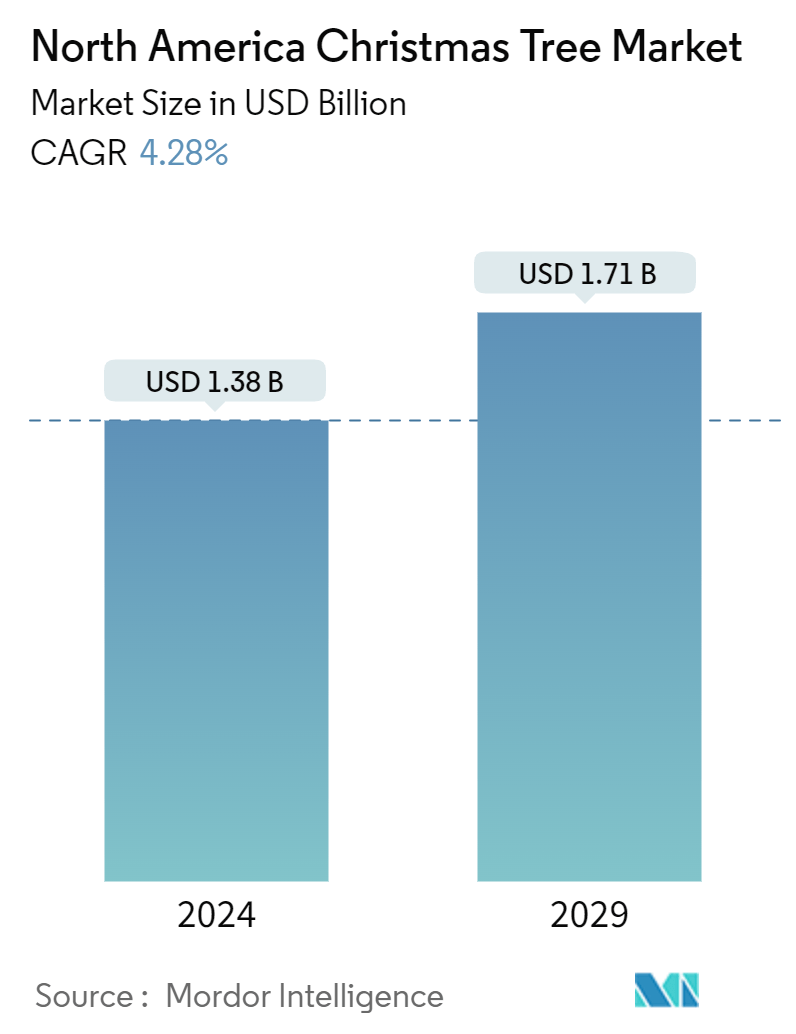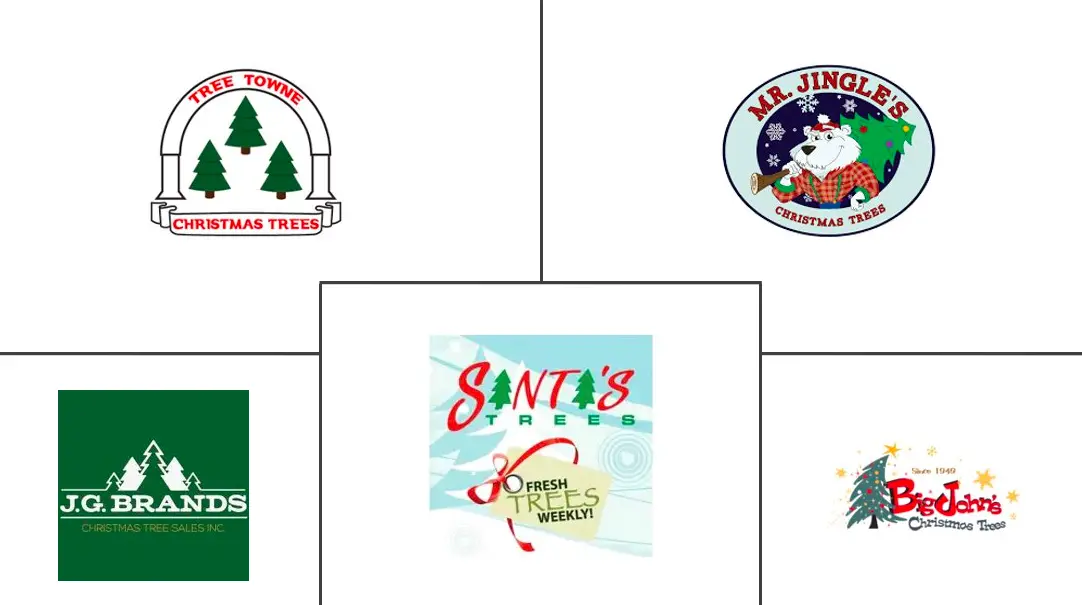Market Size of North America Christmas Tree Industry

| Study Period | 2019 - 2029 |
| Base Year For Estimation | 2023 |
| Market Size (2024) | USD 1.38 Billion |
| Market Size (2029) | USD 1.71 Billion |
| CAGR (2024 - 2029) | 4.28 % |
| Market Concentration | Low |
Major Players
*Disclaimer: Major Players sorted in no particular order |
North America Christmas Tree Market Analysis
The North America Christmas Tree Market size is estimated at USD 1.38 billion in 2024, and is expected to reach USD 1.71 billion by 2029, growing at a CAGR of 4.28% during the forecast period (2024-2029).
The North American Christmas tree market plays a vital role in natural economics, driven by the popularity of natural trees during the holiday season. According to the National Christmas Tree Association (NCTA), 25-30 million real Christmas trees are sold annually, with over 100 million United States households setting up a tree each year. The growing environmental consciousness, especially among millennials, has boosted the demand for natural trees as a more sustainable alternative to artificial variants.
One of the main factors driving the sales of natural trees is the competitive pricing compared to artificial trees. In 2022, natural trees were sold for an average of USD 81.0 per tree, while artificial trees were priced higher at USD 107.0 per tree. Additionally, accessibility to freshly cut trees through online and offline platforms has contributed to the rising sales of real Christmas trees, making it easier for consumers to choose sustainable options. The convenience of buying natural trees online has particularly appealed to eco-conscious millennials.
According to the United States Department of Agriculture (USDA) report in 2022, the United States is the largest market for Christmas trees, with over 15,000 farms producing trees across sizes from 2 to 9,000 acres. Larger farms dominate the market, with around 434 farms controlling 75% of the supply. In recent years, this market has benefited from rising demand for eco-friendly products, ensuring the steady growth of natural Christmas tree production. As sustainability gains importance, the North American Christmas tree market is expected to further expand in the coming years.
North America Christmas Tree Industry Segmentation
A Christmas tree is an ornamented tree, usually an evergreen conifer, such as a spruce, pine, or fir, associated with the festival of Christmas. Natural fresh Christmas trees have been considered under the scope. The North American Christmas tree market is segmented by type (Douglas fir, Noble fir, Fraser fir, Balsam fir, and other types) and geography (United States, Canada, Mexico, and the Rest of North America). The report offers market size and forecasts in value (USD) for all the abovementioned segments.
| Type | |
| Douglas Fir | |
| Noble Fir | |
| Fraser Fir | |
| Balsam Fir | |
| Other Types |
| Geography | |
| United States | |
| Canada | |
| Mexico | |
| Rest of North America |
North America Christmas Tree Market Size Summary
The North America Christmas Tree Market is experiencing a notable expansion, driven by the widespread celebration of Christmas across the region and the increasing preference for natural trees over artificial ones. This shift is largely attributed to a growing awareness of environmental sustainability, particularly among millennials, who favor real Christmas trees for their eco-friendly attributes. The market is characterized by a significant contribution to rural economies, with the United States leading in both production and sales. The price competitiveness between natural and artificial trees further bolsters the demand for real trees, as they are more accessible and cost-effective. Despite the challenges posed by a shortage in domestic supply, the market is poised for growth, supported by the recycling potential of real trees and the emergence of young farmers to sustain production.
The market landscape is highly fragmented, with numerous players competing for market share through strategic expansions and extensive distribution networks. Key states such as Oregon, North Carolina, Michigan, Pennsylvania, and Wisconsin dominate production and sales, while the United States also serves as a major exporter of Christmas trees to various countries. The diverse range of tree species grown across the country caters to the varied consumer preferences, further driving market growth. The inclination towards traditional and sustainable options among consumers is expected to continue, reinforcing the market's upward trajectory during the forecast period.
North America Christmas Tree Market Size - Table of Contents
-
1. MARKET DYNAMICS
-
1.1 Market Overview
-
1.2 Market Drivers
-
1.2.1 Cultural Tradition
-
1.2.2 Growing Consciousness Toward Environmental Sustainability
-
1.2.3 Expansion of Retail Channels
-
-
1.3 Market Restraints
-
1.3.1 High Maintenance and Disposal Efforts
-
1.3.2 Availability of Substitutes
-
-
1.4 Porter's Five Forces Analysis
-
1.4.1 Bargaining Power of Buyers
-
1.4.2 Bargaining Power of Suppliers
-
1.4.3 Threat of Substitutes
-
1.4.4 Threat of New Entrants
-
1.4.5 Intensity of Competitive Rivalry
-
-
-
2. MARKET SEGMENTATION
-
2.1 Type
-
2.1.1 Douglas Fir
-
2.1.2 Noble Fir
-
2.1.3 Fraser Fir
-
2.1.4 Balsam Fir
-
2.1.5 Other Types
-
-
2.2 Geography
-
2.2.1 United States
-
2.2.2 Canada
-
2.2.3 Mexico
-
2.2.4 Rest of North America
-
-
North America Christmas Tree Market Size FAQs
How big is the North America Christmas Tree Market?
The North America Christmas Tree Market size is expected to reach USD 1.38 billion in 2024 and grow at a CAGR of 4.28% to reach USD 1.71 billion by 2029.
What is the current North America Christmas Tree Market size?
In 2024, the North America Christmas Tree Market size is expected to reach USD 1.38 billion.

